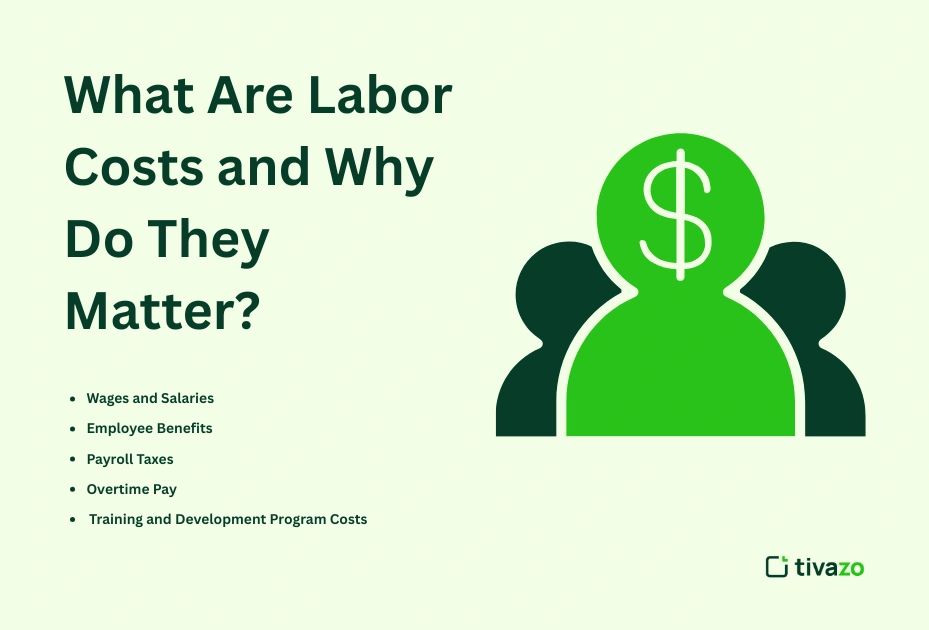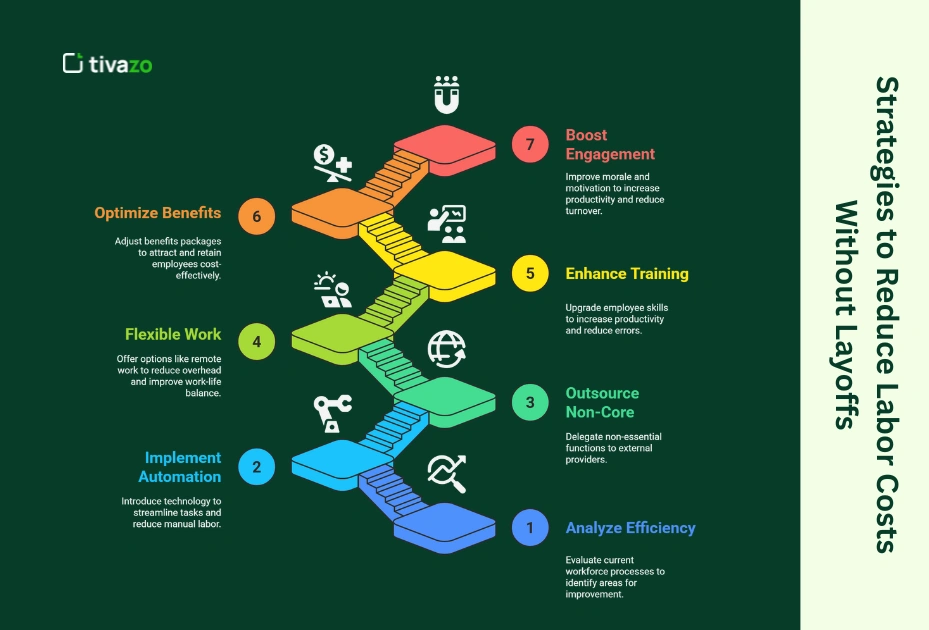Saving on labor costs is one of the highest priorities for companies looking to improve profitability while remaining competitive. Labor cost is also a substantial portion of a company’s overall costs, which means if you can efficiently manage your labor costs, it usually leads to a better bottom line. Although many companies intuitively look to layoffs as an opportunity to cut costs, there can be substantial consequences due to loss of employee morale, loss of experienced employees, and potential long-term damage to company culture.
Ultimately, there are SMARTER and SUSTAINABLE ways to reduce labor costs while avoiding layoffs. In a moment, I will offer you 7 strategies that have been proven to help businesses reduce labor costs while maintaining and improving employee motivation, productivity & engagement. By implementing these operationally practical suggestions, companies will not only be able to save money on costs, but they will also create an efficiently productive, positive working environment that encourages growth and success in and outside of the workplace.
Keys Takeaways:
- What Are Labor Costs and Why Do They Matter?
- Proven Strategies to Reduce Labor Costs Without Layoffs
- Conclusion
- FAQs:
What Are Labor Costs and Why Do They Matter?

Before we jump into the best ways to minimize labor costs, it is important to first understand what the labor costs really are and why they are so important to a company’s overall financial health.
Labor costs include any expenses that a company incurs to employ its workers (team members). It is not as simple as employees just getting paid; labor costs also include several important components:
- Wages and Salaries: The primary compensation that team members receive for their labor, by the hour or salary, and often is the largest portion of labor costs.
- Employee Benefits: The common benefits like health insurance, retirement plans, paid time off, etc. Benefits obviously increase employee satisfaction but also represent a large expense to the overall labor costs.
- Payroll Taxes: Employers pay taxes (Social Security, Medicare, unemployment taxes, etc.) that make up a portion of the labor costs. So while an employee may earn $30 an hour when they are hired, the employer has a labor cost that is more than the wage.
- Overtime Pay: If team members earn overtime for working extra hours beyond their scheduled hours, the company has an additional labor cost, and labor costs can increase quickly when not monitored well.
- Training and Development Program Costs: When companies invest in training and development programs to train employees to learn new skills, this is considered further investment which adds to the labor costs, but may also increase productivity in the future.
In professional settings, labor costs are among the largest costs for businesses and staff costs can be over 50% of total costs for some businesses. So managing labor and its cost is fundamental to profitability and growth.
High labor costs, without justifying productivity, can undermine the competitiveness of the business. And if businesses cannot invest in innovation and growth initiatives to sustain the business, that presents a threat to their survival. Finding efficient and effective ways to reduce labor cost has become a strategic priority for managers and owners of businesses as they want to keep their business healthy and competitive.
Proven Strategies to Reduce Labor Costs Without Layoffs

Strategy 1: Analyze Workforce Efficiency
The first step to lowering labor costs is the analyze how effective your workforce is in terms of how efficiently they are utilized. Analyzing workforce efficiency means tracking productivity closely to identify when resources are wasted and tasks are duplicated.
- Tracking productivity reveals when labor is wasted: As you analyze productivity by measuring output versus the time it requires, you gain insight into employees or departments that are less productive than their peers, whether from underperformance or simply overload. This allows you to redistribute work or reorganize workloads in a more productive way.
- Using tools and software to track productivity: Using tools like time tracking software, project management tools, and performance dashboards offer visibility into workforce performance. Examples of these tools include Tivazo and Asana.
- Eliminating and reallocating low-value tasks: After identifying productivity and performance issues, you can eliminate low-value tasks altogether, or automate them as will be explored in the next strategy. If we’re able to eliminate low-value tasks and reallocate the workforce to high-value, high-impact work, then generally productivity improves.
Regular workforce efficiency analysis helps to reduce wasted labor hours, which translates into labor costs, without letting employees go.
Strategy 2: Implement Automation and Technology

When used wisely, automation can help make smart reductions to your labor costs.
- Automation tools reduce manual work and save time: By implementing automation tools and practices, you should be able to accurately track and/or automate many administrative work processes, including payroll processing, scheduling, and attendance tracking. This automatically reduces your time, overhead, and reduces the errors that could potentially create issues with compliance and payroll.
- Helpful Automation Tool Examples: Sourcing tools like BambooHR for HR management, Deputy or When I Work for scheduling, and QuickBooks or Gusto for payroll, to name a few, help to streamline activities and save money.
- More time to conduct value-worthy activities: Re-thinking the way work processes are completed will allow your employees who were responsible for administrative work, to work on marketing, sales, and strategic-focused activities to add the most value from which they drive revenue, instead of doing the same repetitive tasks as they performed in the past.
In summary, automation leads to more than just reduced labor hours doing repetitive work; it will increase the accuracy and satisfaction of the employee(s) using the software to get work done.
Strategy 3: Outsource Non-Core Tasks
Outsourcing is a useful way to reduce labor costs, while keeping your core team intact.
- Definition: Outsourcing is an arrangement where you hire outside firms and/or freelancers to do specified work/tasks or projects. Off-shoring is a type of outsourcing where you take work off-shore or to lower cost countries.
- Examples of work that can be outsourced: Examples of non-core work that you can outsource include accounting, customer service, IT support, payroll processing, and copywriting. Most of these functions don’t require, nor need, dedicated, full-time employees who are in-house.
- Benefits: Outsourcing reduces fixed labor costs (salaries, benefits) into variable costs (pay for service), and allows your team to focus on core and productive business functions.
Intelligent outsourcing of non-core duties can create significant labor cost savings whilst maintaining quality service or even improving it.
Strategy 4: Adopt Flexible Work Arrangements
Flexible work arrangements have become a popular choice, and they can also result in considerable labor cost savings.
- Types of Flexibility: Remote work, part-time schedules, staggered shifts, job sharing, and compressed workweeks.
- Cost savings potential: Flexible scheduling can decrease overtime, decrease absenteeism, and decrease associated costs of the building/facility (e.g., utilities and square footage). Remote work, ideally, reduces physical square footage.
- Examples of savings: Each of the companies that have noted savings were big companies with thousands of employee whereafter they began a flexible work policy, and benefited from a reduction in labor-related costs and higher employee satisfaction because they offered flexible work options. Dell, Salesforce, and Microsoft – to name a few.
Flexible work arrangements are a win-win by saving costs while improving your employee’s sense of work-life balance.
Strategy 5: Enhance Employee Training Programs
Investing in employee training may feel like a cost these days. However, you can actually reduce your labor costs over time when you hire a well-trained employee.

- Value of Cross-Training or Upskilling Employees: An employee that is trained in multiple skills/competencies can fill different roles and decrease the need for another hire or overtime.
- Increased productivity: Being well trained means an employee is less likely to make mistakes, to work slower, or be unsupervised, which in turn saves time and money.
- Reduced cost: Employees that stay with an employer because they have a career development options, means the employer is ‘saving’ costs in recruitment and onboarding as there is more likely that they will not have to repeat the personnel recruiting process again.
Training programmes also ‘increase’ workforce agility and efficiency by increasing knowledge competency but also reduce labour costs by increasing efficiency.
Strategy 6: Optimize Employee Benefits
Updating and customizing your employee benefits packages will allow you to control costs with minimal negative impact to morale.
- Review benefits regularly: Some of the benefits you provide may not be used fully or found to be more costly than necessary. Instead of eliminating these benefits, you could offer some of them at a lower cost, and some are much lower cost, such as wellness programs, flexible spending accounts, or voluntary benefits.
- Control overtime: Overtime is often a predominate portion of labor cost, so by managing hours efficiently, and through employee scheduling of workloads, you will be able to limit overtime opportunities.
- Encourage low-cost benefits: Even small things can help to move the needle, such as; employee recognition programs, flexible leave days, or opportunities for remote work, and thus you would build morale without substantial cost.
Through benefits optimization, you can maintain an attractive workplace, while keeping labor costs sustainable.
Strategy 7: Boost Employee Engagement and Morale
Strong levels of employee engagement have been shown to improve productivity with reduced labor costs.
- Engagement and morale connected: Employees who are motivated will work more effectively and efficiently, take less sick time, as well as stay in the organization longer which optimizes turnover periods.
- Recognition program: Appreciating achievement becomes a loyalty booster, and also a performance driver if done on a regular basis.
- Team-building opportunities: Overall team-building activities can help them develop a positive culture and co-operation with each individual, or perhaps a sub-group provide improved outputs collectively.
By maintaining your focus on engagement, you will ensure your workforce are productive and dedicated, and that you ultimately have a reduced need for hiring or overtime which in turn keep your costs manageable through labor.
Conclusion
Cutting labor costs does not equal compromising quality, cutting corners, or having to lay off much respected and valued team members. To be honest, several of the best ways to cut labor costs also strengthen your workforce and workplace culture. By utilizing the 7 proven and successful methods in this guide from analyzing workforce productivity and adding automation or other efficiencies to outsourcing or eliminating nonessential tasks to improving employee engagement/culture, managers can cut labor costs dramatically, without losing a productive team or diminishing motivation.
These actionable, tactical and sustainable methods allow you to enhance your operational efficiency, eliminate waste, and strengthen employee engagement without the drastic move of laying off people. Additionally, when implemented with deliberate practice, these methods not only allow business managers to look for ways to cut costs – but they also boost agility, adaptability, and responsiveness in business.
If you take the time to conduct a review of your current cost structure and labor practices so you can determine what is effective and how efficiency could be gained on others processes, you will be in a position to start applying smarter ways to cut labor costs. The end result will be a reduction in operational costs, increased efficient team performance, and a healthier workplace culture that is coping with economic change to be future-oriented.
FAQs:
How can you reduce labor costs?
There are several ways you can decrease costs associated with labor—such as automating recurring tasks, utilizing freelancers for non-essential work, implementing a hybrid model for those who can work out of the office, and training employees to increase productivity. These methods of reducing labor costs are beneficial as they are efficient and sustainable, both helping businesses save money without sacrificing performance or morale.
Which of the following would help reduce labor cost?
Several actions can help, including:
Invest in the use of automation/process efficiencies, tracking technologies
- Improve your scheduling to reduce overtime
- Cross train to complete multiple roles
- Outsource specialty services
For each of these actions, the method supports efficient business operations and allow for smarter labor costs reductions.
What are the ways of reducing cost?
Broadly speaking, businesses can reduce costs by improving process efficiencies, minimizing waste; renegotiating supplier contracts; and controlling labor costs. With regard to workforce management, the best ways to decrease labor costs are to schedule efficiently, create fewer and fewer overtime hours, and utilize data and dashboards to improve employee productivity.
How to reduce labour costs and still save as many jobs as possible?
To reduce labour costs without reducing the size of your team; consider focusing on options that create efficiencies not reduction of size. For example:
- Automate administrative tasks
- Encourage more remote work to lower overhead
- Create part-time job-sharing opportunities
- Provide training for staff to do more with less
These ways to reduce labour costs give businesses the option to make financial savings while trying to be non-invasive to their team structure.
How to break down labor costs?
Labor costs can be broken down into:
Direct costs: wages, salaries, and overtime
Indirect costs: payroll taxes, employee benefits, and training
Understanding this breakdown helps in identifying targeted ways to reduce labor costs without affecting productivity.
How do you optimize labor costs?
To optimize labor costs, analyze where your team spends time and resources. Use scheduling tools to avoid overtime, implement performance tracking systems, and align staffing levels with demand. These are some of the most effective ways to reduce labor costs while maintaining high output and employee satisfaction.




